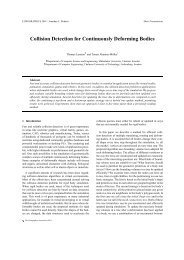Implementation of data collection tools using NetFlow for statistical ...
Implementation of data collection tools using NetFlow for statistical ...
Implementation of data collection tools using NetFlow for statistical ...
You also want an ePaper? Increase the reach of your titles
YUMPU automatically turns print PDFs into web optimized ePapers that Google loves.
1 Introduction<br />
1 Introduction<br />
This introductory chapter will describe the background <strong>of</strong> this thesis, as well what earlier work has<br />
been made in this area. The problem will be <strong>for</strong>mulated followed by the objectives <strong>of</strong> the thesis<br />
work. With this defined, the different methods will be presented and evaluated. Towards the end <strong>of</strong><br />
the chapter the structure <strong>of</strong> the project such as organization, limitations and the outline <strong>of</strong> the rest <strong>of</strong><br />
the report will be described.<br />
1.1 Thesis background<br />
The need <strong>for</strong> protection against cyber attacks increase every day with more and more companies<br />
tied to the Internet even tighter than be<strong>for</strong>e [1]. Internet has become a reliable medium in which one<br />
needs to be seen in able to compete. Various security measures exists today to secure and harden a<br />
company network and its perimeter to the outside world, in case <strong>of</strong> an attack. These attacks vary<br />
both in difficulty and execution time. Attacks might start with reconnaissance, which could be as<br />
simple as dropping a few infected USB memory sticks on the parking lot in an attempt to get an<br />
inside look <strong>of</strong> the network. Attacks in particular that are hard to protect oneself against however, are<br />
the so called Denial <strong>of</strong> Service (DoS) or Distributed Denial <strong>of</strong> Service (DDoS) attacks [3]. These<br />
types <strong>of</strong> attacks aim to flood the targeted server(s) with bogus traffic in an attempt to overwhelm its<br />
resources. If an attacker simultaneously sends a large amount <strong>of</strong> requests to a web server, it has to<br />
respond to all those requests. This <strong>for</strong>ces legitimate requests to be put on hold, as the server is busy<br />
handling a massive amount <strong>of</strong> fake requests. If the stream <strong>of</strong> requests from the attacker does not<br />
cease and the server is kept busy the users would experience the site as slow or unresponsive.<br />
Another type <strong>of</strong> attack involves starting a connection and not completing it, leaving it in a half-open<br />
state. When a TCP connection is made, the client start by sending a SYN (synchronize) packet to<br />
the server. The server respond with a SYN-ACK (synchronize acknowledgment), confirming the<br />
request. Finally the client sends its own ACK, confirming the connection. The server waits until it<br />
receives the final acknowledgment, however if a client omits to send it the server will in turn be<br />
kept in a waiting state <strong>for</strong>ever, and thereby tying up resources. If enough connections are made, its<br />
resources will be exhausted and unable to process legitimate requests. [24]<br />
One method <strong>of</strong> mitigating the effects from these type <strong>of</strong> attacks is to identify the IP addresses <strong>of</strong> the<br />
attackers involved and block them from the network. In order to accomplish this one needs to<br />
collect traffic in<strong>for</strong>mation from the network, separating bogus traffic from legitimate traffic and act<br />
accordingly.<br />
One suite <strong>of</strong> such <strong>data</strong> collecting <strong>tools</strong> is called pmacct [4], which is a collector <strong>for</strong> network traffic<br />
in<strong>for</strong>mation. It works by collecting in<strong>for</strong>mation from senders and recipients throughout the network,<br />
including the source- and destination address. With the added feature <strong>of</strong> being able to track BGP<br />
AS-numbers, aggregating all flows from a particular ISP would effectively monitor traffic sent to-<br />
and from that ISP. The pmacct suite will be evaluated at an Internet Service Provider <strong>for</strong> testing and<br />
evaluation. It will first be implemented and configured on a small scale in their network and then<br />
evaluated. If the results are positive, pmacct will then be implemented throughout their entire core<br />
network.<br />
The testing will take place in Stockholm, at an Internet Service Provider called Internet 2 Business<br />
KB (I2B). Internet 2 Business Sverige KB was founded at the second half <strong>of</strong> 2009 by Fredrik<br />
11

















